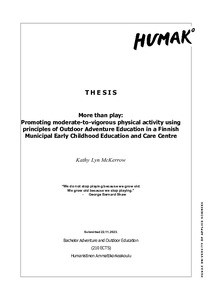More than play: promoting moderate-to-vigorous physical activity using principles of Outdoor and Adventure Education in a Finnish municipal early childhood education and care centre
McKerrow, Kathy Lyn (2023)
McKerrow, Kathy Lyn
2023
All rights reserved. This publication is copyrighted. You may download, display and print it for Your own personal use. Commercial use is prohibited.
Julkaisun pysyvä osoite on
https://urn.fi/URN:NBN:fi:amk-2023112631720
https://urn.fi/URN:NBN:fi:amk-2023112631720
Tiivistelmä
The purpose of this study was to investigate if moderate-to-vigorous physical activity (M-VPA) levels can be increased amongst pre-school children attending a Finnish municipal early childhood education and care centre (ECEC). The role of physical activity as a foundation for healthy lifestyles is well documented. The need to promote more active and less sedentary lifestyles key to reducing the burden of non-communicable diseases. For researching this topic a direct observational physical activity diary using a modified OSRAC-P categories and codes was conducted to collect baseline data. Children (aged 5 to 6 years) were observed
during their afternoon outdoor playtime, usually playing while waiting for parent pick-up.
Adult-led outdoor activities and games were played with the children for 3 weeks (twice a week) during outdoor afternoon playtime. Principles of Outdoor and Adventure Education were applied using games or activities that favoured moderate-to-vigorous physical movement. Games and activities requiring little to no equipment were prioritised. A post intervention direct observational physical activity diary using OSRAC-P was completed the following week. Quantitative methods were applied to analyse the results. The first week generated 540 observation intervals from 4 to 6 focal children. The final observation diary generated 480 observation intervals from 4 to 6 focal children. The results indicate that
physical activity levels increased by 11% for moderate activity and 33 % for vigorous physical activity. Children ranked all the games and activities played during the intervention period, indicating they would play 73 percent of the games again. Future work could see seasonal posters created and a short 3 week introduction program to introduce new games and activities to children. There is a need for future research of a more longitudinal nature to see if school yard games taught at ECEC translate into more active children when they start attending school.
during their afternoon outdoor playtime, usually playing while waiting for parent pick-up.
Adult-led outdoor activities and games were played with the children for 3 weeks (twice a week) during outdoor afternoon playtime. Principles of Outdoor and Adventure Education were applied using games or activities that favoured moderate-to-vigorous physical movement. Games and activities requiring little to no equipment were prioritised. A post intervention direct observational physical activity diary using OSRAC-P was completed the following week. Quantitative methods were applied to analyse the results. The first week generated 540 observation intervals from 4 to 6 focal children. The final observation diary generated 480 observation intervals from 4 to 6 focal children. The results indicate that
physical activity levels increased by 11% for moderate activity and 33 % for vigorous physical activity. Children ranked all the games and activities played during the intervention period, indicating they would play 73 percent of the games again. Future work could see seasonal posters created and a short 3 week introduction program to introduce new games and activities to children. There is a need for future research of a more longitudinal nature to see if school yard games taught at ECEC translate into more active children when they start attending school.
